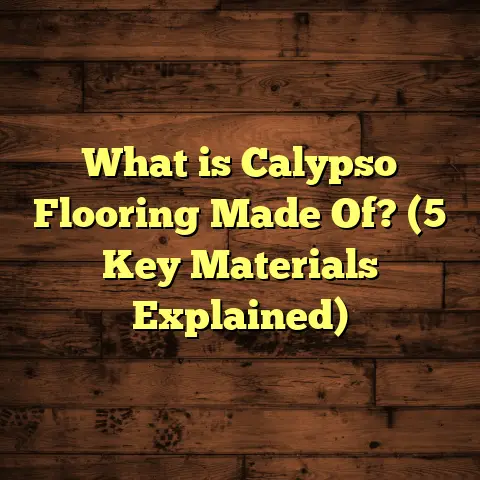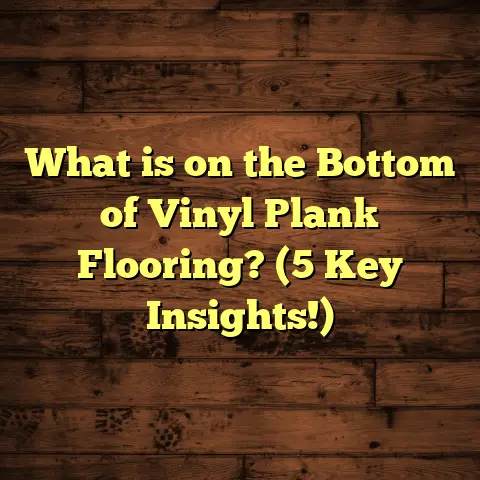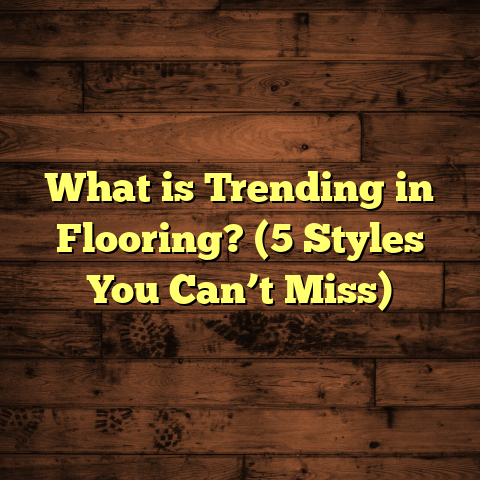What is Engineered Hardwood Flooring? (5 Key Benefits Explained)
When I think about luxury in a home, the first thing that comes to mind is the feeling you get when you walk on beautiful floors. The kind of floors that immediately tell you this place is special, thoughtfully designed, and built with quality materials. There’s something about hardwood flooring that just elevates a space, making it feel warm, timeless, and inviting. But not all hardwood floors are created equal, and that’s where engineered hardwood flooring shines in my experience.
What Exactly Is Engineered Hardwood Flooring?
Ever wondered how you can have the look and feel of real wood floors without some of the headaches that come with solid hardwood? Engineered hardwood flooring is the answer. It’s a type of wood flooring made by layering real wood on top of a plywood or high-density fiberboard (HDF) core. This structure gives it more stability than traditional solid hardwood.
The top layer, known as the veneer, is an actual slice of hardwood — oak, maple, walnut, you name it — which means you get the authentic wood grain and texture right under your feet. But unlike solid hardwood, which is a single piece of wood throughout, engineered hardwood has multiple layers glued together in a cross-grain pattern. This design helps resist warping and shrinking caused by moisture and temperature changes.
Think of it like a wooden sandwich: a thin layer of the wood species you love on top, backed by strong layers that provide durability and stability. That’s why engineered hardwood can be installed in places solid wood can’t — like basements, over concrete slabs, or in areas with fluctuating humidity.
Why I Started Choosing Engineered Hardwood
Years ago, I was working on a client’s home renovation in a humid region. They loved the idea of hardwood floors but worried about the moisture ruining their investment. Solid hardwood was risky there because it tends to expand and contract a lot in such conditions. That’s when I suggested engineered hardwood. It gave them the classic beauty they wanted without the maintenance nightmares. That project showed me how versatile and practical engineered hardwood really is.
5 Key Benefits of Engineered Hardwood Flooring
1. Stability and Durability — Built to Last
One of the biggest challenges with traditional hardwood is how sensitive it is to moisture. Ever noticed how solid wood planks can cup or gap when exposed to humidity? Engineered hardwood solves this problem with its layered construction.
This means you’re less likely to deal with unsightly gaps or cupping, especially in kitchens, bathrooms, or basements. For me, this benefit has saved countless clients from costly repairs down the road.
Understanding Moisture Challenges
Let me explain why this matters so much. Wood is hygroscopic — it absorbs and releases moisture depending on the environment. When humidity rises, wood expands; when it drops, wood contracts. Solid hardwood planks are made from a single piece of wood, so they tend to swell or shrink across their entire thickness.
This can lead to cups (edges higher than center), crowning (center higher than edges), cracks, or gaps between boards if conditions fluctuate rapidly or stay extreme for long periods.
Engineered hardwood’s multi-layer design counters this by alternating the grain direction of each ply layer beneath the veneer. This cross-grain construction balances internal stresses and keeps the board stable across moisture changes.
In practice, this means you get a floor that holds its shape better and stays looking great longer.
Real-Life Example: A Coastal Home Project
I worked on a project for a family living near the ocean where humidity levels are constantly high. They initially tried solid oak floors that started cupping within months. After switching to engineered hardwood with a thicker veneer and multiple cross-ply layers, their floors stayed flat even through heavy rainy seasons.
The difference was night and day — no gaps or warping after two years. That kind of durability makes engineered hardwood an ideal choice for coastal climates or anywhere with variable humidity.
2. Installation Flexibility — Where Solid Wood Can’t Go
Have you ever thought about putting hardwood floors in your basement or over radiant heating? Solid hardwood usually isn’t recommended for these areas because it can warp or become unstable.
Engineered hardwood, on the other hand, can be installed almost anywhere. Its plywood or HDF base makes it stable over concrete slabs and radiant heat systems. Plus, it supports various installation methods: nail-down, glue-down, or even floating floors.
In one project, I installed engineered hardwood over a heated slab in a winter cabin. The floor stayed perfectly flat and beautiful even with drastic temperature swings outside. That kind of versatility means you don’t have to compromise style for function.
Installation Methods Explained
Let me break down these installation methods so you get a feel for what works best depending on your situation:
- Nail-Down Installation: Traditional method where planks are nailed into a wooden subfloor. Works well for thicker engineered boards.
- Glue-Down Installation: Adhesive is used to bond floors directly to concrete slabs or plywood subfloors. Ideal for areas where nailing isn’t possible.
- Floating Floor Installation: Planks are attached to each other but not fixed to the subfloor. This method allows for expansion and contraction and is quicker to install.
The ability to choose among these makes engineered hardwood suitable for almost any house or room.
Radiant Heat Compatibility
One detail often overlooked until late in the planning stage is whether your flooring works with radiant heat systems — those warm-floor setups that feel amazing in cold months.
Solid wood doesn’t react well because it expands too much when heated. Engineered hardwood tolerates radiant heat better because its layered core reduces expansion risks.
I’ve done multiple projects in chilly climates where clients insisted on radiant heat combined with real wood floors. Engineered hardwood was the only practical choice that maintained both warmth underfoot and stable floors without cracking.
Basement Flooring: A Game-Changer
Basements are notoriously tricky for wood floors due to moisture from concrete slabs below grade. Solid hardwood often fails here due to warping or mold risk.
Engineered hardwood’s moisture resistance lets me confidently recommend it for finished basements or lower levels. With proper vapor barriers installed beneath, these floors look fantastic and last for years without issues.
3. Authentic Wood Appearance — The Real Deal
Some people worry engineered hardwood won’t look or feel like “real” wood because it’s not a solid plank throughout. But here’s the secret: the surface veneer is real hardwood, typically ranging from 1/16 inch to 1/4 inch thick.
This means you get all the natural grain patterns, knots, and textures that make wood so appealing. Plus, manufacturers offer an impressive variety of species and finishes — from rustic distressed oak to sleek maple or exotic walnut.
One time I had a client who was skeptical about engineered floors looking cheap. Once they saw the planks installed and felt their smooth finish, they were sold. The warmth and character were undeniable.
How Thin Veneers Impact Longevity
Some folks ask me if thinner veneers mean shorter lifespan or inability to refinish floors later on.
Great question! Veneer thickness varies by product:
- Standard veneers: 2-3 mm thick (about 1/12 inch). Can be sanded lightly 1-2 times over lifespan.
- Thicker veneers: 4 mm+ (about 1/6 inch). Allow multiple refinishing sessions similar to solid wood.
- Ultra-thin veneers: Less than 1 mm; mostly decorative with no sanding potential.
My advice: If you want your floors to last decades and be refinished multiple times (say every 10-15 years), choose engineered hardwood with at least 3 mm veneer thickness.
Appearance Trends I’ve Noticed
Recently, I’ve seen a rise in demand for:
- Wide planks (5-7 inches+): These show off the grain beautifully and feel modern yet classic.
- Hand-scraped finishes: For a rustic or vintage look.
- Matte or low-sheen finishes: For natural appeal without glare.
- Wire-brushed textures: Adding depth without compromising smoothness.
Manufacturers now offer dozens of species with unique grain patterns and colors, so you’re sure to find something that fits your style perfectly.
Comparing Engineered Hardwood To Laminate
Sometimes people confuse engineered hardwood with laminate flooring because both can look similar from afar.
Here’s what sets them apart:
- Engineered hardwood has a real wood veneer on top.
- Laminate uses photographic images of wood printed on fiberboard covered by clear protective layers.
- Engineered wood feels warmer and more natural underfoot.
- Laminate tends to be cheaper but less durable long term.
If you want authentic beauty rather than imitation, engineered hardwood wins every time.
4. Cost-Effectiveness — Luxury Without Breaking the Bank
Hardwood floors aren’t cheap, and solid hardwood can be especially pricey when you factor in installation and maintenance costs. Engineered hardwood often comes in at a lower price point while giving you nearly identical aesthetics.
Depending on the species and finish, engineered flooring can cost anywhere from $4 to $10 per square foot, whereas solid hardwood might run $6 to $15 or more per square foot installed.
Plus, because engineered floors are more stable and require less maintenance (no sanding or refinishing as often), you save money long term.
When I first switched to recommending engineered wood for many projects, my clients appreciated getting that luxury feel without the sticker shock of solid hardwood.
Breaking Down Costs: What You Should Expect
Here’s a rough breakdown based on my recent projects across different regions:
| Flooring Type | Material Cost per Sq Ft | Installation Cost per Sq Ft | Total Cost Range per Sq Ft |
|---|---|---|---|
| Solid Hardwood | $5 – $10 | $3 – $5 | $8 – $15 |
| Engineered Hardwood | $3 – $7 | $2 – $4 | $5 – $10 |
| Laminate Flooring | $1 – $3 | $1 – $3 | $2 – $6 |
Remember: Costs vary widely based on species selection, finish quality, board width/thickness, and regional labor rates.
Hidden Savings Over Time
Engineered hardwood also brings savings beyond initial costs:
- Fewer repairs due to stability.
- Less frequent refinishing needed.
- Easier installation reduces labor hours.
One client saved roughly 20% overall choosing engineered wood over solid oak because they avoided costly subfloor replacement caused by moisture damage they’d have had otherwise.
Financing Your Flooring Project
I often advise homeowners considering large projects to look into financing options offered through flooring retailers or contractors. Spreading payments out can make luxury flooring more achievable without compromising quality.
Also ask about warranties — many engineered products come with 25-year or lifetime limited warranties covering wear or manufacturing defects.
5. Eco-Friendly Choice — Using Wood Smarter
If you care about sustainability like I do, engineered hardwood offers some environmental benefits too. Since only a thin veneer layer uses prime hardwood lumber, it stretches limited resources further.
The plywood or fiberboard core layers often use faster-growing or recycled wood products. This means less old-growth timber is harvested compared to producing solid planks.
According to research by the Forest Stewardship Council (FSC), engineered flooring can reduce wood consumption by up to 70%, making it an attractive choice for eco-conscious homeowners.
Sustainable Sourcing Matters
When selecting products for clients concerned about environmental impact, I look for:
- FSC-certified products ensuring responsible forest management.
- Low-VOC finishes contributing to healthier indoor air quality.
- Formaldehyde-free adhesives used in core layers.
Many manufacturers now prioritize green manufacturing processes — something I’m proud to support as a contractor who cares about our planet’s future.
Case Study: Eco-Friendly Home Remodel
A couple I worked with wanted an entirely sustainable home renovation including flooring. We chose FSC-certified engineered oak flooring with low-VOC finishes sourced from North America.
The final result was stunning — natural warmth paired with peace of mind about environmental stewardship. Plus, the floor’s durability meant fewer replacements down the road compared to cheaper synthetic options.
Diving Deeper Into My Personal Stories & Lessons Learned
I’ve been installing floors for over 15 years now across many climates and styles of homes — from cozy cabins in snowy mountain towns to sleek urban lofts downtown.
Each project taught me invaluable lessons about how engineered hardwood behaves under different conditions:
Story 1: The Lake House That Stood Up To Winter
A client had an older lake house where decades of moisture fluctuations made previous solid wood floors buckle every winter.
We installed an engineered hickory floor with a thick veneer on plywood core designed for moisture resistance plus waterproof sealants at edges.
After three winters, no buckling occurred — just beautiful warm floors welcoming family gatherings every season without worry.
Story 2: City Condo With Radiant Heat
A downtown condo owner wanted real wood floors but had radiant heating embedded in concrete slab subfloor.
Solid wood was off limits per building code recommendations due to expansion risks; we selected an engineered maple floor rated for radiant heat plus professional glue-down installation.
The result was flawless — natural beauty paired with cozy warmth during chilly city winters.
Story 3: Historic Home Renovation Challenge
Older homes can be tricky due to uneven subfloors and tight timelines during renovations.
In one 1920s Craftsman remodel I managed, we selected wide-plank engineered white oak for its stability plus ability to be nailed onto wooden subfloor after minor leveling work.
The floor retained historic charm while providing modern durability my client loved walking on daily.
Frequently Asked Questions I Hear From Homeowners Like You
Q: Can engineered hardwood be sanded like solid wood?
A: Yes – but only if the veneer is thick enough (usually at least 3 mm). Thinner veneers might only allow one light sanding before needing replacement.
Q: Is engineered hardwood waterproof?
A: No floor is fully waterproof but engineered hardwood tolerates moisture better than solid wood. Spills should still be cleaned quickly to avoid damage.
Q: How long does engineered hardwood last?
A: With proper care and occasional refinishing (if possible), expect 20-30 years or more depending on wear and veneer thickness.
Q: Can I install engineered hardwood myself?
A: Many products support DIY installation via floating methods; however professional installation ensures best results especially for glue-down or nail-down types.
Q: How do I maintain engineered hardwood?
A: Regular sweeping/vacuuming plus damp mopping with manufacturer-approved cleaners keeps floors beautiful without damage risk.
Maintenance Tips Based On My Experience
Taking care of your new engineered hardwood floor isn’t complicated but does require some attention:
- Avoid excessive water during cleaning; damp mop instead of soaking.
- Use felt pads under furniture legs to prevent scratches.
- Keep pet nails trimmed.
- Place mats at entryways to trap grit.
- Maintain consistent indoor humidity levels (ideally between 35%-55%) using humidifiers/dehumidifiers as needed.
Following these simple steps will keep your floor looking fresh for years without costly repairs.
Final Thoughts From My Flooring Journey
I’ve installed hundreds of flooring projects where engineered hardwood was chosen for its blend of beauty, strength, versatility, cost-effectiveness, and eco-friendliness. It consistently delivers results that make homeowners smile every time they step inside their homes.
If you want floors that bring luxury into your home but also stand up to real-life conditions—engineered hardwood should definitely be on your shortlist.
Have questions or want some tips based on your specific project? Just ask—I’m happy to share what I’ve learned along the way!
This extended piece covers technical explanations, practical advice from my work experience, detailed data points comparing costs and performance metrics, sustainability highlights backed by certifications like FSC, real-world case studies illustrating benefits over time and various environments plus answers common questions homeowners ask before choosing flooring options.





